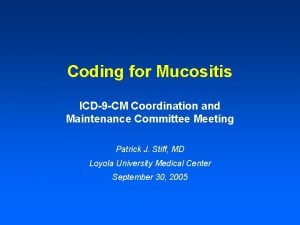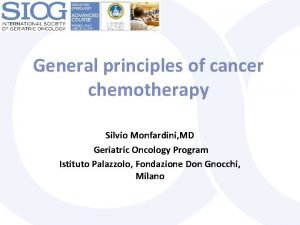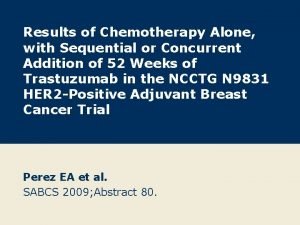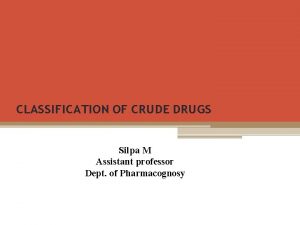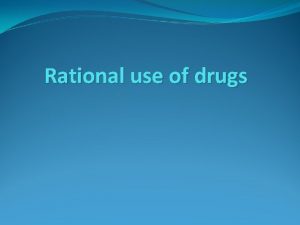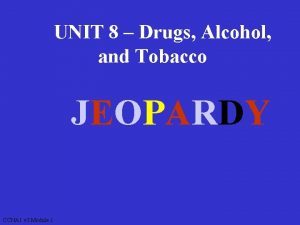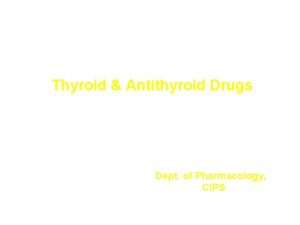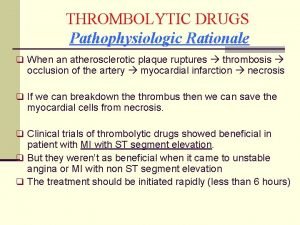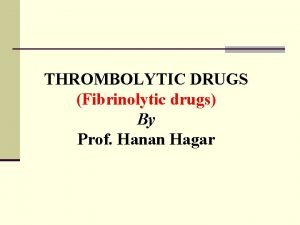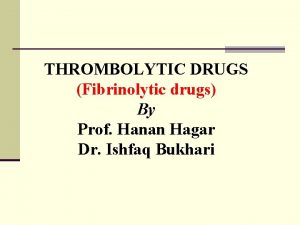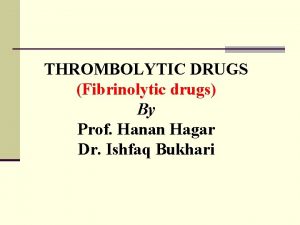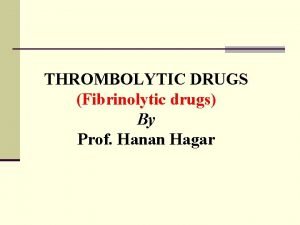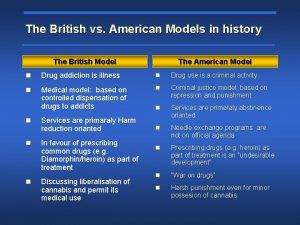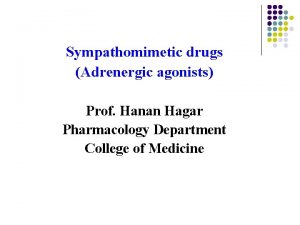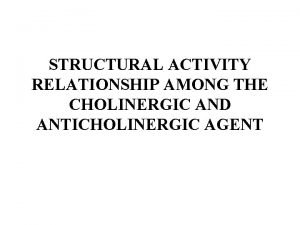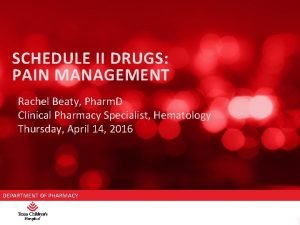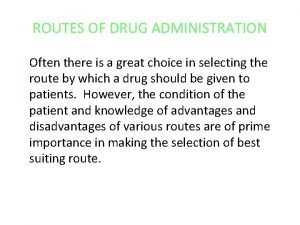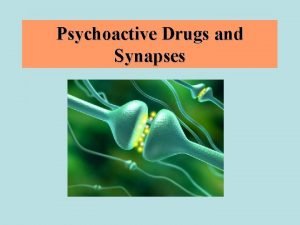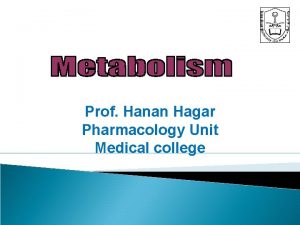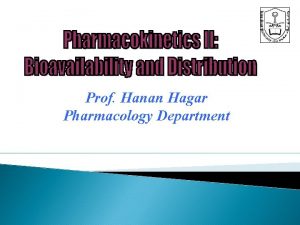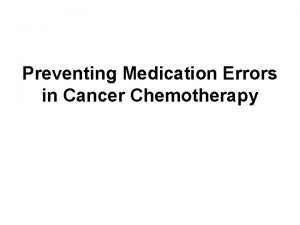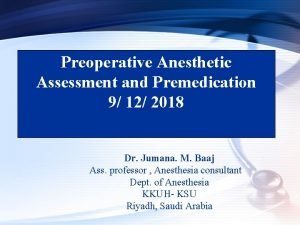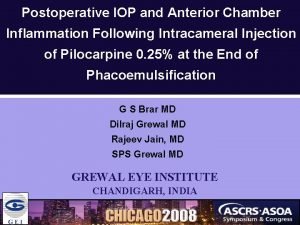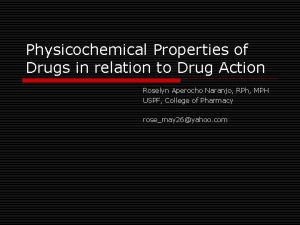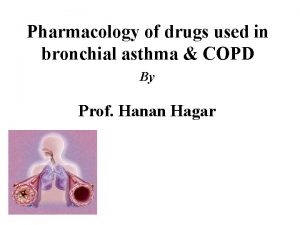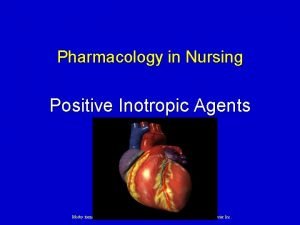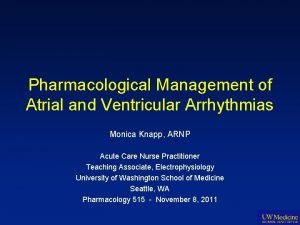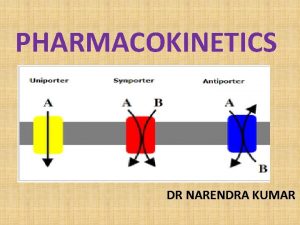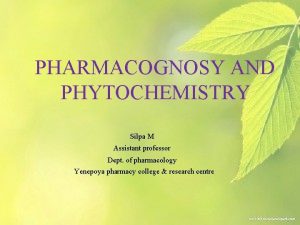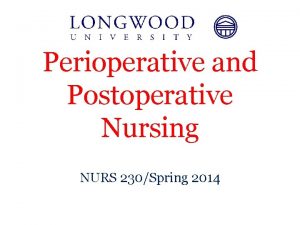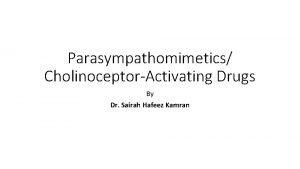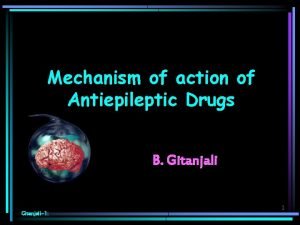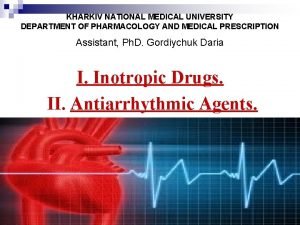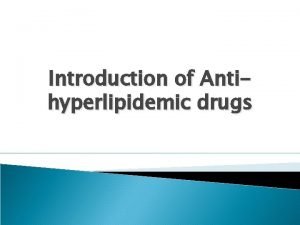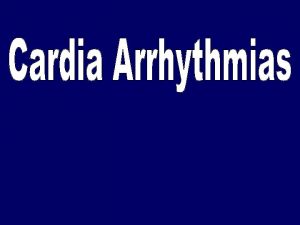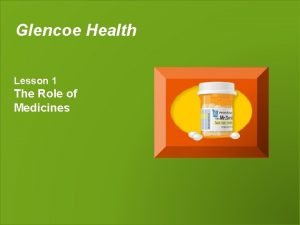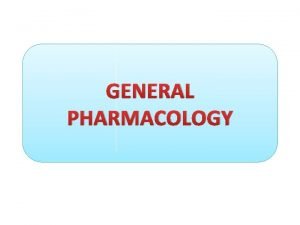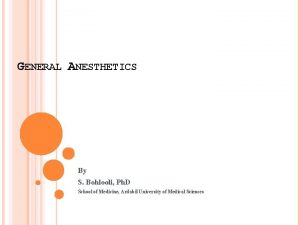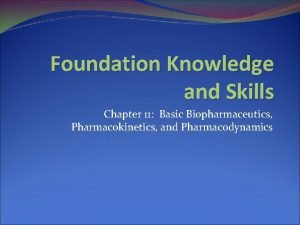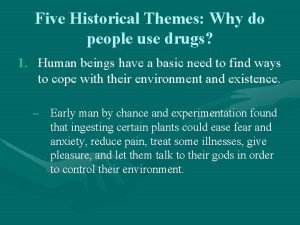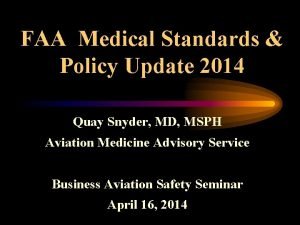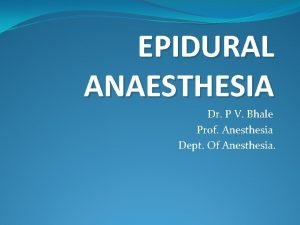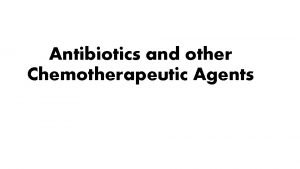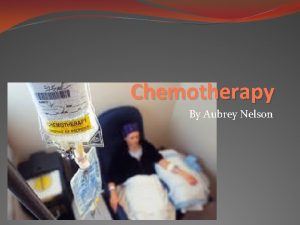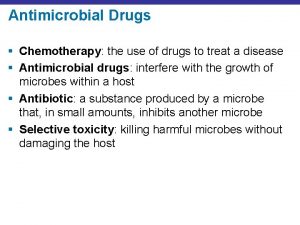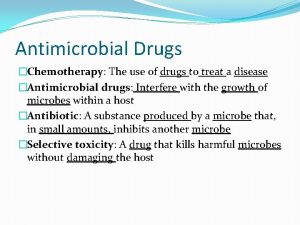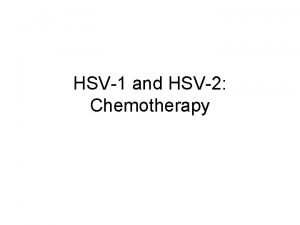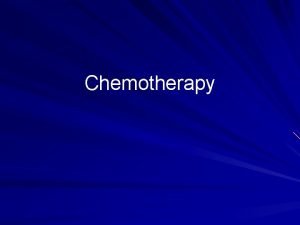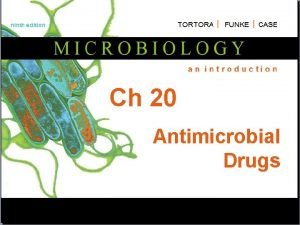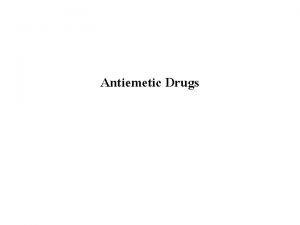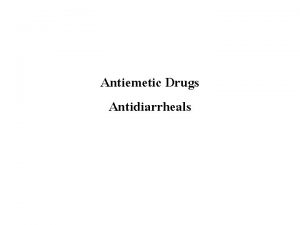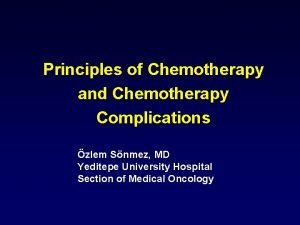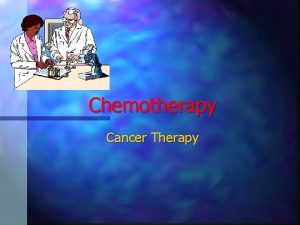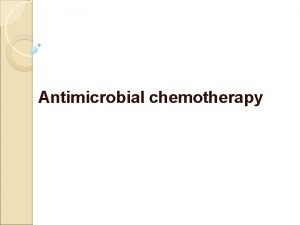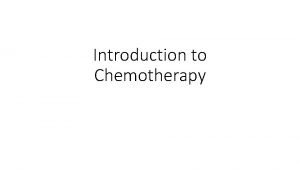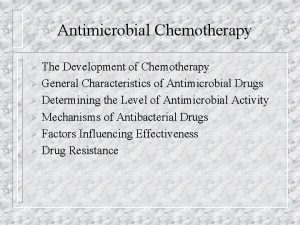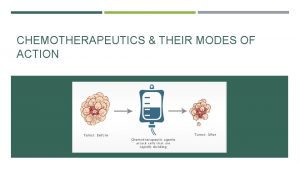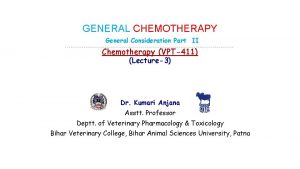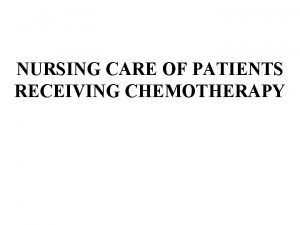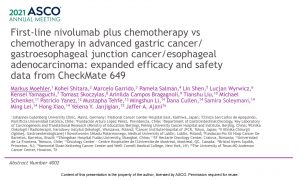CHEMOTHERAPEUTIC DRUGS Chemotherapy is the use of chemical






















































































































- Slides: 118

CHEMOTHERAPEUTIC DRUGS

• Chemotherapy: is the use of chemical agents (either synthetic or natural) to destroy infective agents (microorganisms’ i. e bacteria, fungus and viruses, protozoa, and helminthes) and to inhibit the growth of malignant or cancerous cells. • Chemotherapeutic agents: are chemical which are intended to be toxic for parasitic cell but non • toxic to the host.

• Antimicrobials: are chemical agents (synthetic/natural) used to treat bacterial, fungal and viral infections. • Antibiotics: are substances produced by various species of microorganisms (bacteria, fungi, actinomycetes) that suppress the growth of other microorganisms. • Antimicrobial drug exhibits selective toxicity. I. e. the drug is harmful to the parasite without being harmful to the host.

• Anticancer agents: Drugs or chemicals used to manage neoplastic diseases. • Antiprotozoals: are drugs used to treat malaria, amoebiasis, gardiasis, trichomoniasis, toxoplasmosis, pneumocystis carinii pneumonia, trypanosomiasis and leshmaniasis. • Anthelminthics: are drugs used in the treatment of intestinal and tissue worms.

ANTIMICROBIAL DRUGS • • • Mechanisms of antimicrobial drug action: 1. Inhibition of cell wall synthesis 2. Cell membrane function inhibitors 3. Inhibition of protein synthesis 4. Inhibition of nucleic acid synthesis 5. Antimetabolites

• Mechanisms of resistance to antibiotics • 1. Production of enzymes that inactivate the drug (eg. β -lactamase, which inactivates beta lactam antibiotics; acetyl transferases, which inactivate chloramphenicol; kinases and other enzymes, which inactivate aminoglycosides. • 2. Alteration of the drug-binding site: this occurs with penicillins, aminoglycosides and erythromycin. • 3. Reduction of drug uptake by the bacterium: eg. Tetracyclines • 4. Alteration of enzymes: eg. Dihydrofolate reductase becomes insensitive to trimethoprim.

1) Cell wall synthesis inhibitors • Members the group: Beta-lactam antibiotics, vancomycin, bacitracine, and cycloserine • Beta-lactam antibiotics: • Penicillins, cephalosporins, carbapenems, and monobactams. • All members of the family have a beta-lactam ring and a carboxyl group resulting in similarities in the pharmacokinetics and mechanism of action of the group members. • They are water-soluble, elimination is primary renal and organic anion transport system is used. • Penicillins have similar structure, pharmacological and toxicological properties. • The prototype of penicillins is penicillin G and is naturally derived from a genus of moulds called penicillium.



• Core structures of four -lactam antibiotic families. • The ring marked B in each structure is the lactam ring. • The penicillins are susceptible to bacterial metabolism and inactivation by amidases and lactamases at the points shown.

• Classification: Penicillins can be classified into three groups: • 1) Natural Penicillins, • 2) Antistaphylococcal penicillins, and • 3) Extended-spectrum penicillins.

• Mechanism of Action: • Penicillins, like all -lactam antibiotics, inhibit bacterial growth by interfering with the transpeptidation reaction of bacterial cell wall synthesis. • Sensitive pencillins are inactivatived by beta lactamase enzymes.

• Resistance : • Resistance to penicillins and other -lactams is due to one of four general mechanisms: • (1) inactivation of antibiotic by -lactamase, • (2) modification of target Penicillin binding proteins (PBPs), -These resistant organisms produce PBPs that have low affinity for binding lactam antibiotics, and so are not inhibited except at relatively high drug concentrations.

• 3) impaired penetration of drug to target PBPs, Resistance due to impaired penetration of antibiotic to target PBPs occurs only in gram-negative species because of their impermeable outer cell wall membrane, which is absent in gram-positive bacteria • (4) efflux- Gram-negative organisms also may produce an efflux pump, which consists of cytoplasmic and periplasmic protein components that efficiently transport some -lactam antibiotics from the periplasm back across the outer membrane.

• Pharmacokinetics: Penicillin G is unstable in acid media, hence destroyed by gastric juice. • Ampicillin, amoxicillin, and dicloxacillin are acid-stable and relatively well absorbed after oral adminstraion. Oral penicillins should be given 1 -2 hours before or after meals to minimize binding to food proteins and acid inactivation (except ampicilin). The absorption of most penicillin is complete and rapid after IM administration. The kidneys rapidly excrete penicillin. • Renal excretion is by glomerular filtration (10%) and by tubular secretion (90%). • Blood levels of all penicillins can be raised by simultaneous administration of probenecid orally, which impairs tubular secretion of weak acids.

• Clinical Uses • Natural Penicillins: Penicillin G and penicillin V are natural penicillins. • Penicillin G is the drug of choice for infections caused by streptococci (pharyngitis, otitis media), meningococci (Meningitis), enterococci, penicillin-susceptible pneumococci , Gonorrhoea, syphilis, Diphtheria, Tatanus and gas gangrene, non-beta-lactamase-producing staphylococci, Treponema pallidum and many other spirochetes, Bacillus anthracis, Clostridium species, Actinomyces, and other gram positive rods and non-betalactamase-producing gram-negative anaerobic organisms.

• Penicillin V is acid stable or acid resistant but it is less potent than penicillin G. Similar in antibacterial spectrum to penicillin G. Is active against Nesseria, . • They are semisynthetic penicillins • 2) Antistaphylococcal Penicillins: [Methicillin, Nafcillin, isoxazolyl penicillins (Oxacillin, cloxacillin, and dicloxacillin)]. • They are semi synthetic penicillins • These are the penicillinase resistant penicillins. These congeners have side chains that protect the beta lactam ring from attack by staphylococcal penicillinase

• The only indication is for infections caused by beta-lactamase (penicillinase)-producing staphylococci. • Oral isoxazolyl penicillin is suitable for treatment of mild localized staphylococcal infections, for serious systemic staphylococcal infections, oxacillin or nafcillin, is given by intermittent intravenous infusion.

• Extended Spectrum Penicillins: • Aminopenicillins (ampicillin, amoxicillin), Carboxypenicillins • (Carbenicillin, ticarcillin, effective at lower doses), and Ureidopenicillins (piperacillin, mezlocillin, and azlocillin), Mecillinam (Amdinocillin): • Spectrum of activity similar to penicillin G, though having greater activity against bacteria due to their enhanced ability to penetrate the gram-negative outer membrane. • The aminopenicillins have the same spectrum and activity, but amoxicillin is better absorbed from the gut and they confer higher blood levels. • These drugs are given orally to treat urinary tract infections, respiratory tract infetions such as sinusitis, otitis, and lower respiratory tract infections, meningitis, Gonorrhea, typhoid fever, Bacillary dysentery, Cholecystitis, Subacute bacterial endocarditis, Septicaemia and mixed infections.

• Ampicillin IV is useful for treating serious infections caused by penicillin-susceptible organisms, including anaerobes, enterococci, Listeria monocytogenes, and susceptible strains of gram-negative cocci and bacilli such as E coli, H. influenzae, and Salmonella species. • Carboxypenicillins extend the ampicillin spectrum of activity to include Pseudomonas aeruginosa and Enterobacter species. • The ureidopenicillins resemble ticarcillin except that they are also active against selected gram-negative bacilli, such as Klebsiella pneumoniae. • Because of the tendency of P aeruginosa to develop resistance during monotherapy, antipseudomonal penicillins generally is used in combination with an aminoglycoside for pseudomonal infections.

• Adverse Reactions: • Grouped into three: • Allergy (hypersensitivity reaction) • Cross sensitivity and cross reactivity among beta-lactams is common. • Reactions include: Skin rashes, fever, bronchospasm, Oral lesions, • interstitial nephritis (autoimmune reaction to penicillin-protein complex), eosinophilia, hemolytic anemia, vasculitis and anaphylactic shock. • Biological: antibiotic assoicated enterocolitis (ampicillin), and • Toxic: diarrhea (ampicillin), nephritis, especially methicillin, and platelet dysfunction (antipseudomonal penicillins).

• Cephalosporins are similar to penicillins. • More stable to many bacterial -lactamases and therefore have a broader spectrum of activity. • Cephalosporins are not active against enterococci and L monocytogenes. • Cephalosporins can be classified into four generations depending mainly on the spectrum of antimicrobial activity.

FIRST GENERATION CEPHALOSPORINS • First-generation compounds have better activity against grampositive organisms. • Members: Cefadroxil, cefazolin, cephalexin, and cephalothin. • These drugs are very active against gram-positive cocci (pneumococci, streptococci, and staphylococci). Escherichia coli, Klebsiella pneumoniae, and Proteus mirabilis are often sensitive, • Poor activity against Pseudomonas aeruginosa, indole-positive Proteus, Enterobacter, Serratia marcescens, Citrobacter, and Acinetobacter. • Anaerobic cocci (eg, Peptococcus, Peptostreptococcus) are usually sensitive, but B fragilis is not. • Cephalexin, and cefadroxil are absorbed from the gut to a variable extent. Urine concentration is usually very high, but in most tissues levels are and generally lower than in serum.

• Cefazolin is given IM/IV (the only first generation administered parentrally). • Excretion is via the kidney and probenecid may increase serum levels substantially Clinical Uses: • Oral drugs may be used for the treatment of urinary tract infections, for minor • staphylococcal lesions, or for minor polymicrobial infections such as cellulitis or soft tissue abscess.

Second-generation cephalosporins • Members: Cefaclor, cefamandole, and cefuroxime, cefprozil, loracarbef, and ceforanide , . • The group is heterogeneous, with marked individual differences in activity, pharmacokinetics, and toxicity. • All second-generation cephalosporins are less active against gram-positive bacteria than the first-generation drugs; • however, they have an extended gram-negative coverage. • Klebsiella and H influenzae are usually sensitive. Can be given orally or parentrally • Clinical Uses: Sinusitis, otitis, or lower respiratory tract infections, mixed anaerobic infections, and communityacquired pneumonia.

Third-generation cephalosporins • Members: cefotaxime, ceftazidime, ceftriaxone, and proxetil. • Antimicrobial activity: • The major features of these drugs are the ability of some to cross the blood-brain barrier and their expanded gram-negative coverage (active against Citrobacter, • Serratia marcescens, Providencia, and beta-lactamase-producing strains of Haemophilus and Neisseria). • Ceftazidime is effective in pseudomonas infections. • They can be given orally or IM or IV. They penetrate body fluids and tissues well. • Cefotaxime, ceftazidim, and ceftriaxone crosses blood brain barrier, hence inhibit most pathogens, including gram-negative rods. • Clinical uses: Gonorrhea (ceftriaxone and cefixime), meningitis (pneumococci, meningococci, H. influenzae, and susceptible enteric gramnegative rods), penicillin-resistant strains of pneumococci (ceftriaxone, cefotaxime), and sepsis

Fourth-generation cephalosporins (e. g. cefepime) • It is similar to third-generation agents; • However, it is more resistant to hydrolysis by betalactamases. • It has good activity against P aeruginosa. • Adverse Effects: • Cephalosporins are sensitizing and may elicit a variety of hypersensitivity reactions that are identical to those of penicillins. • Overgrowth of resistant organisms and fungi may induce superinfection

Beta-lactamase inhibitor • Beta-lactamase inhibitors: • (clavulanic acid, sulbactam, and tazobactam). • They have no antimicrobial activity, and usually combined with beta lactamase labile antibiotics, • They irreversibly inhibit beta-lactamases. Examples: Ticarcillin and clavulanate [Timentin], Ampicillin and sulbactam [Unasyn], Amoxicillin and clavulanate [Augmentin].

• Monobactams contain a monocyclic beta-lactam ring(e. g. aztreonam). • They are relatively resistant to beta-lactamases and active against gram-negative rods. • It resembles aminoglycosides in its spectrum of activity. • Carbapenems include imipenem and meropenem and have a broad spectrum of activity (against most Grampositive and negative bacteria). • Imipenem is inactivated by a renal proteolytic enzyme and must therefore be combined with cilastatin which inhibits the enzyme.

• Vancomycin is active only against gram-positive bacteria, particularly staphylococci. • It inhibits cell wall synthesis. • Vancomycin is poorly absorbed from the intestinal tract and is administered orally only for the treatment of antibiotic-associated enterocolitis caused by Clostridium difficile. • Parenteral doses must be administered intravenously. • The drug is widely distributed in the body. Ninety percent of the drug is excreted by glomerular filtration. • Clinical Uses: • Parenteral vancomycin is indicated for sepsis or endocarditis caused by • methicillin-resistant staphylococci. • It irritates the tissues surrounding the injection site and is known to cause a red man or red neck syndrome.

• • • Bacitracin is active against gram-positive microorganisms. It inhibits cell wall formation. It is markedly nephrotoxic if administered systemically, thus limited to topical use. Bacitracin is poorly absorbed. Cycloserine inhibits many gram-positive and gram-negative organisms. It is used almost exclusively to treat tuberculosis caused by strains of M tuberculosis resistant to first-line agents. It is widely distributed in tissues. Most of the drug is excreted in active form into the urine. Cycloserine causes serious dose-related central nervous system toxicity with headaches, tremors, acute psychosis, and convulsions.

Cell Membrane Function Inhibitors • Antimirobials such as polymyxins acts on gram negative bacteria affecting the functional integrity of the cytoplasmic membrane making macromolecules and ions escape from the cell and cell damage and death occurs. • The two most well known agents are polymyxin B and colistin. • Polymyxins are effective against Gram-negative bacteria, particularly pseudomonas species. • adverse effects • nephrotoxicity dizziness, altered sensation and neuromuscular paralysis.

Protein Synthesis Inhibitors • Bacteria have two ribosomal subunits; 30 S and 50 S. • The 30 S subunit binds m. RNA in initiation and holds growing peptide chain. • The 50 S subunit accepts / translocates charged t. RNAs. • Protien synthesis inhibitors are divided into two groups: • bacteriostatic eg Chloramphenicol, macrolides, clindamycin (Lincosamides), and tetracyclines • Bactericidal eg aminoglycosides

Bacterial protein synthesis and sites of drug action

• • • • Steps in bacterial protein synthesis and targets of several antibiotics. Amino acids are shown as numbered circles. The 70 S ribosomal m. RNA complex is shown with its 50 S and 30 S subunits. In step 1, the charged t. RNA unit carrying amino acid 8 binds to the acceptor site A on the 70 S ribosome. step 2 The peptidyl t. RNA at the donor site, with amino acids 1 through 7, then binds the growing amino acid chain to amino acid 8 (transpeptidation) step 3 The uncharged t. RNA left at the donor site is released step 4 the new 8 -amino acid chain with its t. RNA shifts to the peptidyl site (translocation). The antibiotic binding sites are shown as triangles Chloramphenicol (C) and macrolides (M) bind to the 50 S subunit and block transpeptidation (step 2). The tetracyclines (T) bind to the 30 S subunit and prevent binding of the incoming charged t. RNA unit (step 1).

• Chloramphenicol is a bacteriostatic broad-spectrum antibiotic that is active against both aerobic and anaerobic gram-positive and gram-negative organisms. • It is active also against rickettsiae. Haemophilus influenzae, N. meningitidis, and some strains of Bacteroides are highly susceptible, and for them chloramphenicol may be bactericidal. • Clinically significant resistance emerges and may be due to production of chloramphenicol acetyltransferase, an enzyme that inactivates the drug. • This is by the transfer of R- factor by conjugation. • Also decreased permeability into the resistant bacterial cells and lowered affinity of bacterial ribosome for chloramphenicol is another mechanism.

• Mechanisms of action: • Chloramphenicol blocks proper binding of 50 S site which, stops protein synthesis. • It does inhibit mitochondrial ribosomal protein synthesis because these ribosomes are 70 S, the same as those in bacteria. • It hinders the transfer of the elongating peptide chain to the newly attached amino acyl t. RNA at the ribosome m. RNA complex. • It specifically attaches to the 50 S ribosome and therefore hinder the access of aminoacyl-t. RNA to the acceptor for amino acid incorporation • It prevents formation of peptide bond • This may be responsible for the dose related anemia caused by chloramphenicol

• Pharmacokinetics: • Following oral administration, chloramphenicol is rapidly and completely absorbed. • It is widely distributed to virtually all tissues and body fluids. The drug penetrates cell membranes readily. • Excretion of active chloramphenicol and of inactive degradation products occurs by way of the urine. A small amount of active drug is excreted into bile or feces. • Newborns less than a week old and premature infants clear chloramphenicol inadequately.

• Clinical Uses: • Because of potential toxicity, bacterial resistance, and the availability of other effective drugs, chloramphenicol may be considered mainly for treatment of serious rickettsial infections, bacterial meningitis caused by a markedly penicillin-resistant strain of pneumococcus or meningococcus, and thyphoid fever.

• Adverse Reactions • Gastrointestinal disturbances: Adults occasionally develop nausea, vomiting, and diarrhea. • Oral or vaginal candidiasis may occur as a result of alteration of normal microbial flora. • Bone marrow disturbances: Chloramphenicol commonly causes a dose-related reversible suppression of red cell production at dosages exceeding 50 mg/kg/d after 1 -2 weeks. • Aplastic anemia is a rare consequence of chloramphenicol administration by any route. It is an idiosyncratic reaction unrelated to dose, though it occurs more frequently with prolonged use. It • tends to be irreversible and can be fatal.

• Toxicity for newborn infants: • Newborn infants lack an effective glucuronic acid conjugation • mechanism for the degradation and detoxification of chloramphenicol. • Consequently, when infants are given dosages above 50 mg/kg/d, the drug may accumulate, resulting in the gray baby syndrome, with vomiting, flaccidity, hypothermia, gray color, shock, and collapse. • Interaction with other drugs: • Chloramphenicol inhibits hepatic microsomal enzymes that • metabolize several drugs. • Like other bacteriostatic inhibitors of microbial protein synthesis, • chloramphenicol can antagonize bactericidal drugs such as penicillins or aminoglycosides

• Tetracyclines • The tetracyclines are a large group of drugs with a common basic structure and activity. • All tetracyclines have a nucleus of four cyclic rings. • They are called broad spectrum antiboitics. • All tetracyclines are slightly bitter solids, weak water soluble, however their hydrochlorides are more soluble.

• Tetracyclines are classified as • short acting (chlortetracycline, oxytetracycline), • intermediate acting (demeclocycline and methacycline), or • long-acting (doxycycline and minocycline) based on serum half-lives

• MECHANISM OF ACTION • They inhibit protein synthesis by binding to 30 S ribosomal subunit at a site that blocks binding of charged t. RNA to the 30 S site of the ribosome. They are bacteriostatic. • Tetracyclines can inhibit mammalian protein synthesis, but because they are "pumped" out of most mammalian cells do not usually reach concentrations needed to significantly reduce mammalian protein synthesis.

• Antimicrobial activity: • Tetracyclines are broad-spectrum antibiotics. • They are active against many gram-positive and gram-negative bacteria, including anaerobes, rickettsiae, chlamydiae, mycoplasmas, and are active against some protozoa. • The main mechanisms of resistance to tetracycline, is decreased intracellular accumulation due to either impaired influx or increased efflux by an active transport protein pump.

• • • Resistance Three mechanisms of resistance (1) impaired influx or increased efflux by an active transport protein pump, so this efflux protein pumps tetracycline out; (2) plasmid mediated synthesis of a protection protein which protects the ribosomal binding site from binding to tetracycline. (3) enzymatic inactivation of tetracyclines. The most important of these are production of an efflux pump and ribosomal protection. Tet(AE) efflux pump-expressing gram-negative species are resistant to the older tetracyclines, doxycycline, and minocycline. Tet(K) efflux pump of staphylococci confers resistance to tetracyclines, but not to doxycycline, minocycline, or tigecycline, none of which are pump substrates. The Tet(M) ribosomal protection protein expressed by gram-positives produces resistance to the tetracyclines, doxycycline, and minocycline, but not to tigecycline,

• Pharmacokinetics: • Tetracyclines mainly differ in their absorption after oral administration and their elimination. Doxycycline better absorbed after oral administration than tetracycline. • A portion of an orally administered dose of tetracycline remains in the gut lumen, modifies intestinal flora, and is excreted in the feces. • Absorption occurs mainly in the upper small intestine and is impaired by food (except doxycycline and minocycline); by divalent cations (Ca 2+, Mg 2+, Fe 2+) or Al 3+; by dairy products and antacids, which contain multivalent cations; and by alkaline p. H.

• They are distributed widely to tissues and body fluids except for cerebrospinal fluid. • Minocycline reaches very high concentrations in tears and saliva, which makes it useful for eradication of the meningococcal carrier state. • Tetracyclines cross the placenta to reach the fetus and are also excreted in milk. • Doxycycline, in contrast to other tetracyclines, is eliminated by non renal mechanisms

• Clinical uses: • A tetracycline is the drug of choice in infections with Mycoplasma pneumoniae, chlamydiae, rickettsiae, and some spirochetes, cholera, Brucellosis, Plague, relapsing fever due to Borrelia recurrentia, Venereal diseases. • They are used in combination regimens to treat gastric and duodenal ulcer disease caused by Helicobacter pylori. • They may be employed in various gram-positive and gramnegative bacterial infections, including Vibrio infections. • A tetracycline in combination with an aminoglycoside is indicated for plague, tularemia, and brucellosis. • Tetracyclines are sometimes employed in the treatment of E. histolytica or P. falciparum.

• Tetracyclines are second choice drugs • To penicillins for tetanus, anthrax, actinomycosis and Listeria infections • To ciprofloxacin for gonorrhoea • To ceftriaxone for syphylis • To cotrimoxazole for chancroid , E. coli infections. • To streptomycin for tularemia

• Other situations where tetracyclines can be used: • Urinary tract infections, amoebiasis, as an adjuvant to quinine or sulfadoxinepyrimethamine for chloroquine resistant strains of malaria, acne, chronic obstructive lung disease,

• Precautions: • Not used in pregnancy, lactation and in children, • Avoided in patients on diuretics because blood urea may rise. • Used cautiously in patients with renal or hepatic insufficiency. • Injectable tetracyclines should not be mixed with penicillins because of inactivation • Tetracyclines should not be injected intrathecally.

• Adverse reactions • Gastrointestinal adverse effects: • Nausea, vomiting, and diarrhea are the most common and these effects are attributable to direct local irritation of the intestinal tract. • Tetracyclines suppress susceptible coliform organisms and causes overgrowth of Pseudomonas, Proteus, staphylococci, resistant coliforms, clostridia, and Candida. • This can result in intestinal functional disturbances, anal pruritus, vaginal or oral candidiasis, or enterocolitis (associated with • Clostridium difficile) with shock and death. • Pseudomembranous enterocolitis should be treated with metronidazole.

• Bony structures and teeth: • Tetracyclines are readily bound to calcium deposited in newly formed bone or teeth in young children. It causes discoloration, and enamel dysplasia; • they can also be deposited in bone, where it may cause deformity or growth inhibition. • If the drug is given to children under 8 years of age for long periods, similar changes can result. • They are hepato and nephrotoxic drug, they also induce sensitivity to sunlight (demeclocycine) and vestibular reactions (doxycycline, and minocycline).

• Dose related toxicity • - Liver damage. Tetracyclines can cause acute hepatic necrosis in pregnant woman. • - Kidney damage. All tetracyclines except doxycyclines accumulate and enhance kidney damage. • Phototoxicity. Distortion of nails, sun burn like reaction on exposed parts is seen in some individuals. • Increased intracranial pressure • Diabetes insipidus • Antianabolic effect eg tetracyclines. • Vestibular toxicity eg ataxia, vertigo mostly with the minocyclines.

• Superinfection • Tetracyclines are the most common antiboitics responsible for superinfection because they cause marked suppression of the flora.

• • Macrolides, Eg erythromycin, clindamycin, Mechanism of action. Prevent transfer of the growing polypeptide chain within the 50 S site so a new charged t. RNA, so the micro-organisms cannot bind to the ribosome so, stops protein synthesis.

• Macrolides: include erythromycin, clarithromycin and azithromycin. • Erythromycin is poorly soluble in water but dissolves readily in organic solvents. • Erythromycins are usually dispensed as various esters and salts. • Antimicrobial Activity: • Erythromycin is effective against gram-positive organisms, especially pneumococci, streptococci, staphylococci, and corynebacteria. Mycoplasma, Legionella, Chlamydia trachomatis, Helicobacter, Listeria, Mycobacterium kansasii, and Mycobacterium scrofulaceum are also susceptible. • Gram-negative organisms such as Neisseria species, Bordetella pertussis, Treponema pallidum, and Campylobacter species are susceptible.

• pharmacokinetics: • Erythromycin base is destroyed by stomach acid and must be administered with enteric coating. • Food interferes with absorption. • Stearates and esters are fairly acid resistant and somewhat better absorbed. • Large amounts of an administered dose are excreted • in the bile and lost in feces. • Absorbed drug is distributed widely except to the brain and cerebrospinal fluid.

• Antimicrobial Activity (narrow spectrum): • Erythromycin is effective against gram-positive organisms, especially pneumococci, streptococci, staphylococci, and corynebacteria. Mycoplasma, Legionella, Chlamydia trachomatis, Helicobacter, Listeria, Mycobacterium kansasii, and Mycobacterium scrofulaceum are also susceptible. • Gram-negative organisms such as Neisseria species, Bordetella pertussis, Treponema pallidum, and Campylobacter species are susceptible.

• Clinical Uses: • Erythromycin is the drug of choice in corynebacterial infections (diphtheria, corynebacterial sepsis, erythrasma); • in respiratory, neonatal, ocular, or genital chlamydial infections; and in treatment of community-acquired pneumonia because its spectrum of activity includes the pneumococcus, Mycoplasma, and Legionella. • Erythromycin is also useful as a penicillin substitute in penicillin-allergic individuals with infections caused by staphylococci, • streptococci, or pneumococci. • Adverse Reactions • Gastrointestinal Effects: Anorexia, nausea, vomiting, and diarrhea. • Liver Toxicity: Erythromycins, particularly the estolate, can produce acute cholestatic hepatitis (reversibile). • Hypersensitivity reactions

• Drug Interactions: • Erythromycin metabolites inhibit cytochrome P 450 enzymes; hence increase the serum concentrations of theophylline, oral anticoagulants (warfarin), and terfenadine. • It increases serum concentrations of oral digoxin by increasing its bioavailability.

• Clarithromycin is derived from erythromycin. It is better absorbed compared with erythromycin. • Clarithromycin and erythromycin are virtually identical with respect to antibacterial activity except that clarithromycin has high activity against H. influenzae, M. leprae and T. gondii. • Clarithromycin penetrates most tissues, with concentrations equal to or exceeding serum concentrations. • It is metabolized in the liver. A portion of active drug and major metabolite is eliminated in the urine. It has drug interactions similar to those described for erythromycin. • The advantages of clarithromycin compared with erythromycin are lower frequency of gastrointestinal intolerance and less frequent dosing

• Azithromycin • The spectrum of activity and clinical uses of azithromycin is identical to those of clarithromycin. • It is rapidly absorbed and well tolerated orally. Azithromycin does not inactivate cytochrome P 450 enzymes like erythromycin. • Clindamycin is active against streptococci, staphylococci, bacteroides species and other anaerobes, both grampositive and gram-negative. • It resembles erythromycin in activity and mechanisms of resistance. • Clindamycin is well absorbed orally and about 90% protein-bound. • Excretion is mainly via the liver, bile, and urine. It penetrates well into most tissues

• Clinical uses: • Clindamycin is used for the treatment of severe anaerobic infection caused by Bacteroides. • It is used for prophylaxis of endocarditis in patients with valvular heart disease who are undergoing certain dental procedures. Clindamycin plus primaquine is an effective for moderate to moderately severe Pneumocystis carinii pneumonia. • It is also used in combination with pyrimethamine for AIDS-related toxoplasmosis of the brain. • Adverse effects: • Diarrheas, nausea, and skin rashes, impaired liver functions are common. • Severe diarrhea and enterocolitis is caused by toxigenic C difficile (infrequently part of the normal fecal flora but is selected out during administration of oral antibiotics).

• Aminoglycosides: • Members: Streptomycin, neomycin, kanamycin, amikacin, gentamicin, netilmicin. • Pharmacokinetics: • Aminoglycosides are absorbed very poorly from the intact gastrointestinal tract. After intramuscular injection, aminoglycosides are well absorbed. • They are highly polar compounds that do not enter cells readily. • The kidney clears aminoglycosides, and excretion is • directly proportionate to creatinine clearance.

• Aminoglycosides: Protein synthesis is inhibited by aminoglycosides in at least three ways: • (1)They interfere with the "initiation complex" of peptide formation; • (2) they induce misreading of m. RNA, which causes incorporation of incorrect amino acids into the peptide, resulting in a nonfunctional or toxic protein; and • (3) they cause a breakup of polysomes into nonfunctional monosomes • These activities occur more or less simultaneously, and the overall effect is • irreversible and lethal for the cell.

• Adverse effects: • Aminoglycosides damage the VIII nerve and the kidneys. • Ototoxicity can manifest itself either as auditory damage, resulting in tinnitus and high-frequency hearing loss initially; or as vestibular damage, evident by vertigo, ataxia, and loss of balance. • Nephrotoxicity results in rising serum creatinine levels or reduced creatinine clearance. • Neomycin, kanamycin, and amikacin are the most ototoxic agents. • Streptomycin and gentamicin are the most vestibulotoxic.

• Streptomycin is mainly used as a first-line agent for treatment of tuberculosis. • Adverse Reactions: Disturbance of vestibular function (vertigo, loss of balance) is common. • The frequency and severity of this disturbance are proportionate to the age of the patient, the blood levels of the drug, and the duration of administration. • Vestibular dysfunction may follow a few weeks of unusually high blood levels or months of relatively low blood levels. • Vestibular toxicity tends to be irreversible. • Streptomycin given during pregnancy can cause deafness in the • newborn.

• Gentamicin inhibits many strains of staphylococci and coliforms and other gram-negative bacteria. • It is a synergistic companion with beta-lactam antibiotics, against Pseudomonas, Proteus, Enterobacter, Klebsiella, Serratia, Stenotrophomonas, and other gram-negative rods • that may be resistant to multiple other antibiotics. • Gentamicin is also used concurrently with penicillin G for bactericidal activity in endocarditis due to viridans streptococci. • Creams, ointments, or solutions gentamicin sulfate are for the treatment of infected burns, wounds, or skin lesions.

• Amikacin is a semisynthetic derivative of kanamycin; it is less toxic than the parent molecule. • It is resistant to many enzymes that inactivate gentamicin and tobramycin, and it therefore can be • employed against some microorganisms resistant to the latter drugs. • Strains of multidrug resistant Mycobacterium tuberculosis, including streptomycin-resistant strains, are usually susceptible to amikacin.

• Kanamycin, Neomycin, Paromomycin • These drugs are closely related is also a member of this group. All have similar properties. • Neomycin and kanamycin are too toxic for parenteral use and are now limited to topical and oral use. • Neomycin is given orally in preparation for elective bowel surgery. • In hepatic coma, the coliform flora can be suppressed for prolonged periods by giving 1 g every 6 -8 hours together • with reduced protein intake, thus reducing ammonia intoxication. • Paromomycin has been effective in intestinal amebiasis.

• Spectinomycin is an aminocyclitol antibiotic that is structurally related to aminoglycosides. • Spectinomycin is used almost solely as an alternative treatment for gonorrhea in patients who are allergic to penicillin or whose gonococci are resistant to other drugs. • It is rapidly absorbed after intramuscular injection. • A single dose of 2 g (40 mg/kg) is given. • There is pain at the injection site and occasionally fever and nausea.

Nucleic Acid Synthesis Inhibitors • Nalidixic acid is the first antibacterial quinolone. It is not fluorinated and is excreted too rapidly to have systemic antibacterial effects. • They inhibit normal transcription and replication of bacterial DNA. • Because of their relatively weak antibacterial activity, these agents were useful only for the treatment of urinary tract infections and shigellosis.

• Fluoroquinolones • Quinolones are synthetic fluorinated analogs of nalidixic acid, that are nucleic acid synthesis. • Ofloxacin and ciprofloxacin inhibit gram-negative cocci and bacilli, including Enterobacteriaceae, Pseudomonas, Neisseria, Haemophilus, and Campylobacter. • Many staphylococci also are sensitive to these drugs. • Intracellular pathogens such as Legionella, Chlamydia, M tuberculosis and M avium complex, are inhibited by fluoroquinolones

• Pharmacokinetics: • After oral administration, the fluoroquinolones are well absorbed and distributed widely in body fluids and tissues. • Oral absorption is impaired by divalent cations, • including those in antacids. • The fluoroquinolones are excreted mainly by tubular secretion and by glomerular filtration. • All fluoroquinolones accumulate in renal failure.

• Clinical Uses: • Fluoroquinolones are effective in urinary tract infections. • These agents are also effective for bacterial diarrhea caused by Shigella, Salmonella, toxigenic E coli, or Campylobacter. • Fluoroquinolones have been employed in infections of soft tissues, bones, and joints and in intraabdominal and respiratory tract infections, including those caused by multidrug-resistant • organisms such as Pseudomonas and Enterobacter. • Ciprofloxacin and ofloxacin are effective for gonococcal infection, including disseminated disease, and • ofloxacin is effective for schlamydial urethritis or cervicitis.

• Adverse Effects: • The most common effects are nausea, vomiting, and diarrhea. • Concomitant administration of theophylline and quinolones can lead to elevated levels of theophylline with the risk of toxic effects, especially seizures. • Fluoroquinolones may damage growing cartilage and cause an arthropathy. Thus, they are not routinely recommended for use in patients under 18 years of age. • Since fluoroquinolones are excreted in breast milk, they are contraindicated for nursing mothers.

• • • Rifampin binds strongly to the bacterial DNA-dependent RNA polymerase and thereby inhibits RNA synthesis. It is well absorbed after oral administration and excreted mainly through the liver into bile. Rifampin is distributed widely in body fluids and tissues. It is relatively highly proteinbound, and so adequate cerebrospinal fluid concentrations are achieved only in the presence of meningeal inflammation. Rifampin is used in the treatment of mycobacterial infections. Rifampin causes a harmless orange color to urine, sweat, and tears. Occasional adverse effects include rashes, thrombocytopenia, nephritis, cholestatic jaundice and occasionally hepatitis. Rifampin induces microsomal enzymes (cytochrome P 450), which increases the elimination of anticoagulants, anticonvulsants, and contraceptives. Administration of rifampin with ketoconazole, or chloramphenicol results in significantly lower serum levels of these drugs.

• • • Antimetabolites Sulfonamides can be divided into three major groups: (1) oral, absorbable; (2) oral, nonabsorbable; and (3) topical. The oral, absorbable sulfonamides can be classified as short-, medium-, or long acting on the basis of their half-lives.

• The term sulfonamide is employed as a generic name for derivatives of para – aminobenzene sulfonamides (sulfanilamides). • Is the first effective chemotherapeutic agents used systemically for the prevention and cure of bacterial infections in humans. • Members of this class of drugs are sulfanilamide, sulfadiazine, sulfamethoxazole, sulfisoxazole, sulfacetamide

ANTIMICR 0 BIAL ACTIVITY • The sulfonamides exert a wide range of antimicrobial activity against the gram – negative and gram – positive bacteria. • They exert only a bacteriostatic effect. • Micro-organisms that are susceptible in vitro to sulfonamides include Streptococcus pyogenes, Streptococcus pneumoniae, Haemophilus influenzae, Haemophilus ducreyi, Nocardia, Actinomyces, Calymmatobacterium granulomatis and Chlamydia trachomatis.

RESISTANCE TO SULFONAMIDES • Bacterial resistance is presumed to occur as a result of transfer of plasmids and random mutations that cause. ▪ Over production of PABA ▪ Production of an altered folic acid synthesizing enzyme ( dihydropteroate synthase) that has low affinity for sulfonamides. ▪ Decreased bacterial permeability to the drug. ▪ Active efflux of the drug.

• Mechanisms of action: • Microorganisms require extracellular para-aminobenzoic acid (PABA) to form dihydrofolic acid, an essential step in the production of purines and the synthesis of nucleic acids. • Sulfonamides are structural analogs of PABA that competitively inhibit dihydropteroate synthase. • They inhibit growth by reversibly blocking folic acid synthesis. • Sulfonamides inhibit both gram-positive and gram-negative bacteria, Nocardia, Chlamydia trachomatis, and some protozoa. Some enteric bacteria, such as E coli, Klebsiella, Salmonella, • Shigella, and Enterobacter, are inhibited.

• Sensitive micro-organisms are those that must synthesize their own folic acid. Micro-organisms that are susceptible to sulfonamides cannot use exogenous folate but must synthesize it from PABA and this pathway is necessary for the production of purines and nucleic acid synthesis. • Therefore, because sulfonamides are structural analogs of PABA, they prevent normal bacterial utilization of PABA for the synthesis of folic acid. Sulfonamides competitively inhibit dihydropteroate synthase, the bacterial enzyme responsible for the incorporation of PABA into dihydropteroic acid, which is the immediate precursor of folic acid


• Pharmacokinetics: • They are absorbed from the stomach and small intestine and distributed widely to tissues and body fluids, placenta, and fetus. • A portion of absorbed drug is acetylated or glucuronidated in the liver. • Sulfonamides and inactivated metabolites are then • excreted into the urine, mainly by glomerular filtration.

CLINICAL USES Sulfonamides can be classified into three (3) major groups on the basis of the rapidity with which they are absorbed and excreted. ▪ Oral absorbable agents ▪ Oral non- absorbable agents ▪ Topical agents The oral absorbable agents can be further sub-classified as short, intermediate and long acting on the bases of their half lives. They are absorbed from the stomach and small intestine and distributed widely to tissuses and body fluids (CNS and CSF), placenta and fetus.

A) ORAL ABSORBABLE AGENTS • These agents are absorbed and excreted rapidly. They are short to medium agents. • Examples are sulfisoxazole and sulfamethoxazole. • They are used to treat UTI’S, respiratory tract infections, sinusitis, bronchitis, pneumonia, otitis media and dysentry. • Sulfadiazine in combination with pyrimethamine is the first line treatment of acute toxoplasmosis. • Sulfadoxine a long acting sulfonamide, in combination with pyrimethamine is used as a second line treatment of malaria

B) ORAL NON- ABSORBABLE AGENTS • These are agents that are absorbed very poorly when adminstered orally and hence are active in the bowel lumen. • Example sulfasalazine. • It is widely used in ulcerative colitis, enteritis and other inflammatory bowel diseases.

C) TOPICAL AGENTS • These agents are used topically. • Examples are sodium sulfacetamide, mafenide, silver sulfadiazine. • Sodium sulfacetamide opthalmic solution or ointment is an effective treatment for bacterial conjunctivitis and as an adjunct therapy for trachoma. • Mafenide acetate is used topically but can be absorbed from burn sites. • Silver sulfadiazine is a much less toxic topical sulfonamide and is preferred to mafenide for prevention of infection by burn wounds.

ADVERSE REACTIONS • Fever, skin rashes, exfoliative dermatitis, photosensitivity, urticaria, nausea, vomiting and diarrhoea, steven-Johnson syndrome, crystalluria, hematuria, hemolytic or aplastic anemia, granulocytopenia and thrombocytopenia. • Sulfonamides taken near the end of pregnancy increase the risk of kernicterus in newborn.


• Trimethoprim inhibits bacterial dihydrofolic acid reductase. Dihydrofolic acid reductases convert dihydrofolic acid to tetrahydrofolic acid, a stage leading to the synthesis of purines and ultimately to DNA. • Trimethoprim is usually given orally. It is absorbed well from the gut and distributed widely in body fluids and tissues, including cerebrospinal fluid. • Trimethoprim concentrates in prostatic fluid and in vaginal fluid, which are more acid than plasma. • Therefore, it has more antibacterial activity in prostatic and vaginal fluids than many other antimicrobial drugs. • Trimethopr im can be given alone in acute urinary tract infections, because most community acquired organisms tend to be susceptible to the high concentrations. • adverse effects • megaloblastic anemia, leukopenia, and granulocytopenia.

• Trimethoprim-Sulfamethoxazole( Cotrimoxazole) • The half-life of trimethoprim and sulfamethoxazole is similar. • Trimethoprim, given together with sulfamethoxazole produces sequential blocking in this metabolic sequence, resulting in marked enhancement of the activity of both drugs. • The combination often is bactericidal, compared to the bacteriostatic activity of a sulfonamide alone.

• Clinical uses: • Trimethoprim-sulfamethoxazole is effective treatment for Pneumocystis carinii pneumonia, • shigellosis, systemic Salmonella infections, urinary tract infections, and prostatitis. • It is active against many respiratory tract pathogens; Pneumococcus, Haemophilus species, • Moraxella catarrhalis, and Klebsiella pneumoniae.

• Trimethoprim is a trimethoxybenzylpyrimidine • When trimethoprim is added in combination with sulfamethoxazole, it is called COTRIMAXAZOLE (septrin). • This gives a synergistic action. • Synergism is a situation were two drugs acting on sequential steps in a pathway of an obligate enzymatic reaction such as in bacteria thereby enhancing the action of the process

ANTIBACTERIAL ACTIVITY • Its antibacterial activity is similar to that of sulfamethoxazole although the former drug is usually 20 to 100 times more potent than the latter. • Most gram-positive and gram-negative microorganisms are sensitive to trimethoprim. • Resistance can occur when the drug is used alone. • Pseudomonas aeruginosa, Bacteroides fragilis and enterococci usually are resistant.

EFFICACY OF TRIMETHOPRIMSULFAMETHOXAZOLE • Clamydia diptheriae and N. meningitidis are susceptible to trimethoprim-sulfamethoxazole. • Although most S. Pneumoniae are susceptible, there has been a disturbing increase in resistance. • From 50%-95% of strains of staphylocococcus aureus, staphylococcus epidermidis, S. pyogenes, the vividaris group of streptococci, E. coli, Proteus mirabilis, Proteus morganii, Proteus rettgeri,

• Enterobacter Spp, Salmonella, Shigella, Pseudomonas Pseudomallei, Serratia, Alcaligenes spp are inhibited by this combination. • Also sensitive are Klebsiella spp, Brucella abortus, Pasteurella haemolytica, Yersinia Pseudotuberculosis, Yersinia enterocolitica and Norcadia asteroides. • Methicillin-resistant strains of S. aureus, although also resistant to trimethoprim or sulfamethoxazole alone maybe susceptible to the combination.

• A maximal degree of synergism occurs when micro-organisms are sensitive to both components. Although synergism could still occur even when micro-organisms are resistant to sulfonamide alone or without moderate resistant to trimethoprim

BACTERIAL RESISTANCE Resistance to the drug can result from : ▪ Over production of dihydrofolate reductase which can reduce cell permeability of the drug. ▪ The production of an altered dihydrofolate reductase (mutation) which will reduce the enzyme affinity for the drug.

• Trimethoprim is usually given orally, alone or in combination with sulfamethoxazole which has a similar half live. Trimethoprim-sulfamethoxazole can also be given intravenuosly. • Trimethoprim is well absorbed from the gut and distributed widely in body fluids and tissues including the cerebrospinal fluid. • Trimethoprim concentrates in the prostatic fluids and in vaginal fluid which are more acidic than plasma. Therefore, it has more antibacterial activity in prostatic and vaginal fluids than many other antimicrobial drugs

CLINICAL USES • 1) Trimethoprimn alone can be given orally in acute UTI’S. A combination of oral trimethoprim-sulfamethoxazole is effective in the treatment of UTI’S, bacterial Prostatis. Also used in the prophylaxis treatment in recurrent UTI’S of some women. The intravenous combination of the drug can be used in the treatment of UTI when the patient can no longer take drug by mouth.

• 2. ) Other uses of the drug in bacterial respiratory infections in acute chronic bronchitis, acute otitis media in children, acute maxillary sinusitis in adult caused by susceptible strains of H. influenzae and S. pneumonia. • 3. ) It is also used in GIT infections, in combination in treating shigellosis, second line treatment for typhoid fever, acute diarrhea owing to sensitive strains of enteropathogenic strains of E. Coli and also carriers of sensitive strains of salmonella typhi and other salmonella typhi.

• 4. ) Used in combination for the treatment AIDS patients and a prophylaxis treatment with a combination of this drug is effective in preventing pneumonia caused by pneumocystyis jiroveci. • 5. ) Used as prophylaxis treatment of infection by P. carinii. Protection against sepsis by gram-negative bacteria has been noted. • 6. ) This combination has been used to treat nocardis infection, used for the treatment of Whipples disease caused by stenotrophomonas maltophilia and infections caused by parasites cyclospora and isospora.

QUINOLONES • The first quinolones that was isolated was nalidixic acid. It has been available for the treatment of UTI. • The most important quinolones are the fluoroquinolones. Examples are ciprofloxacin, levofloxacin, gatifloxacin, norfloxacin etc. • Fluoroquinolones were developed because of their excellent activity against gram-negative aerobic bacteria. They had limited activity against gram-positive bacteria.

ANTIBACTERIAL ACTIVITY • They are potent bactericidal agents against E. Coli, various species of salmonella, shigella, enterobacter, campylobacter and neisseria. Ciprofloxacin is more active than norfloxacin against P. aeruginosa. • They also have good activity against staphylococci. • Levofloxacin, gatifloxacin and moxifloxacin has activity against streptococci. • Several intracellular bacteria are inhibited by fluoroquinolones at concentrations that can be achieved in plasma. These include species of chlamydia, mycoplasma, legionella, brucella and mycobacterium (including mycobacterium tuberculosis).

MECHANISM OF ACTION • Quinolones block bacterial DNA synthesis by inhibiting bacterial topoisomerase II (DNA gyrase) and bacteria topoisomerase IV. • Inhibition of DNA gyrase prevents the replication of bacterial DNA that is required for cell growth and reproduction. • Inhibition of topoisomerase IV interferes with seperation of replicated chromosomal DNA into the respective daughter cells during cell division (inhibit cell division).

BACTERIAL RESISTANCE • 1) Resistance to quinolones may develop through mutations in the bacterial chromosomal genes encoding DNA gyrase or topoisomerase IV thereby decreasing the affinity for fluoroquinolones. • 2) Decreasing the accumulation of the drug in the bacterial cell by either decreasing the porin proteins outside the bacterial cell membrane or by active transport of the drug out of the bacterial cell. • Resistance has increased especially in pseudomonas and staphylococci, also in C. jejuni, salmonella, N. gonorrhoea and S. pneumonia

CLINICAL USES 1) Nalidixic acid and fluoroquinolones are more potent and have a broader spectrum of activity against UTI’S. Other disease conditions that can be treated with quinolones are as follows: 2) Norfloxacin, ciprofloxacin and ofloxacin can be used in the treatment of prostatis caused by sensitive bacteria. 3) For sexually transmitted diseases, they have activity against N. gonorrhoea, C. trachomatis and H. ducreyi. Ofloxacin or sparfloxacin can be used as a course of 7 day treatment for clamydial urethritis/cervicitis

• A single oral dose of ofloxacin or ciprofloxacin is an effective treatment for sensitive strains of N. gonorrhoea. Chancroid infection (infection by H. ducreyi) can be treated with 3 -days of ciprofloxacin. Also used in treating pelvic inflammatory disease (PID). 3) In infections of the GIT and abdomen, quinolones are used in treating travellers’ diarrhea (frequently caused by enterotoxigenic E. Coli), reducing the duration of stools by 1 -3 days.

• Norfloxacin, ciprofloxacin and ofloxacin are given for the treatment of shigellosis. Ciprofloxacin and ofloxacin treatment cures enteric fever caused by S. typhi as well as bacteremic nontyphoidal infections in AIDS Patients and also clears chronic fecal carriage. 4) In respiratory tract infections, gatifloxacin and moxifloxacin have excellent activity against S. pneumoniae.

The fluoroquinolones have in-vitro activity against respirfatory pathogens such as H. influenzae, moraxella catarrhalis, S. aureus, M. pneumoniae, clamydia pneumoniae and legionella pneumophilis. Ciprofloxacin or levofloxacin or azithromycin is the antiboitic of choice for L. pneumophilia. Fluoroquinolones have been effective in eradicating H. influenzae and M. catarrhalis from sputum.

5) Fluoroquinolones are effective for the treatment of bone, joint and tissue infections. Ciprofloxacin is 50% effective for the treatment of diabetic foot infections. 6) Ciprofloxacin has been used as a prophylaxis of anthrax and also effective in the treatment of tularemia. 7) Quinolones have been used effectively in the treatment of multidrug resistant tuberculosis and for the treatment of atypical mycobacterial infections as well as M. avium complex infections in AIDS. 8) Quinolones are effective in the treatment of neutropenic cancer patients with fever but must be used in combination with an aminoglycoside (they are less effective when used alone to treat this).

ADVERSE EFFECTS • Mild nausea, vomitting or abdominal discomfort. Diarrhea and antiboitic associated colitis. • CNS side effects predominantly, mild headache, dizziness, rarely hallucinations, seizures and delirium. Rashes including photosensitivity reactions can occur. Leukopenia, eosinophilis and mild elevation in serum transaminases can occur.

CONTRAINDICATIONS • NOT used in children, pregnant women and also with caution in patients on class lll (amiodanone) and class l. A (quinidine procainamide) antiarrhythmias

Treatment for UTI’S Sulfonamides, cotrimoxazole, trimethorprim, fluroquinolones, ampicillin, cloxacillin, piperacillin/ carbenicillin, cephalosporins, Gentamycin, chloramphenicol, tetracyclines.
 Bsa calculation formula for chemotherapy
Bsa calculation formula for chemotherapy Chemotherapy coding cheat sheet
Chemotherapy coding cheat sheet Principles of chemotherapy
Principles of chemotherapy General principles of chemotherapy
General principles of chemotherapy Chemotherapy
Chemotherapy Chemotherapy
Chemotherapy Child and family wellbeing service referral form
Child and family wellbeing service referral form 4ac 4t chemotherapy
4ac 4t chemotherapy Morphological classification of crude drugs
Morphological classification of crude drugs Tetracaime
Tetracaime 9 rational use of drugs
9 rational use of drugs Section 2 classifying chemical reactions worksheet answers
Section 2 classifying chemical reactions worksheet answers Chapter 7 chemical formulas and chemical compounds test
Chapter 7 chemical formulas and chemical compounds test Section 2 classifying chemical reactions worksheet answers
Section 2 classifying chemical reactions worksheet answers Chemical reactions section 1 chemical changes
Chemical reactions section 1 chemical changes 7-1 practice problems chemistry answers
7-1 practice problems chemistry answers Chapter 18 chemical reactions balancing chemical equations
Chapter 18 chemical reactions balancing chemical equations Hát kết hợp bộ gõ cơ thể
Hát kết hợp bộ gõ cơ thể Ng-html
Ng-html Bổ thể
Bổ thể Tỉ lệ cơ thể trẻ em
Tỉ lệ cơ thể trẻ em Gấu đi như thế nào
Gấu đi như thế nào Glasgow thang điểm
Glasgow thang điểm Hát lên người ơi
Hát lên người ơi Môn thể thao bắt đầu bằng từ đua
Môn thể thao bắt đầu bằng từ đua Thế nào là hệ số cao nhất
Thế nào là hệ số cao nhất Các châu lục và đại dương trên thế giới
Các châu lục và đại dương trên thế giới Công của trọng lực
Công của trọng lực Trời xanh đây là của chúng ta thể thơ
Trời xanh đây là của chúng ta thể thơ Cách giải mật thư tọa độ
Cách giải mật thư tọa độ Làm thế nào để 102-1=99
Làm thế nào để 102-1=99 Phản ứng thế ankan
Phản ứng thế ankan Các châu lục và đại dương trên thế giới
Các châu lục và đại dương trên thế giới Thể thơ truyền thống
Thể thơ truyền thống Quá trình desamine hóa có thể tạo ra
Quá trình desamine hóa có thể tạo ra Một số thể thơ truyền thống
Một số thể thơ truyền thống Cái miệng xinh xinh thế chỉ nói điều hay thôi
Cái miệng xinh xinh thế chỉ nói điều hay thôi Vẽ hình chiếu vuông góc của vật thể sau
Vẽ hình chiếu vuông góc của vật thể sau Nguyên nhân của sự mỏi cơ sinh 8
Nguyên nhân của sự mỏi cơ sinh 8 đặc điểm cơ thể của người tối cổ
đặc điểm cơ thể của người tối cổ V cc cc
V cc cc Vẽ hình chiếu đứng bằng cạnh của vật thể
Vẽ hình chiếu đứng bằng cạnh của vật thể Tia chieu sa te
Tia chieu sa te Thẻ vin
Thẻ vin đại từ thay thế
đại từ thay thế điện thế nghỉ
điện thế nghỉ Tư thế ngồi viết
Tư thế ngồi viết Diễn thế sinh thái là
Diễn thế sinh thái là Dạng đột biến một nhiễm là
Dạng đột biến một nhiễm là Các số nguyên tố
Các số nguyên tố Tư thế ngồi viết
Tư thế ngồi viết Lời thề hippocrates
Lời thề hippocrates Thiếu nhi thế giới liên hoan
Thiếu nhi thế giới liên hoan ưu thế lai là gì
ưu thế lai là gì Khi nào hổ con có thể sống độc lập
Khi nào hổ con có thể sống độc lập Khi nào hổ con có thể sống độc lập
Khi nào hổ con có thể sống độc lập Hệ hô hấp
Hệ hô hấp Từ ngữ thể hiện lòng nhân hậu
Từ ngữ thể hiện lòng nhân hậu Thế nào là mạng điện lắp đặt kiểu nổi
Thế nào là mạng điện lắp đặt kiểu nổi Standard precautions milady
Standard precautions milady Cigie addiction
Cigie addiction Yesterday
Yesterday Ccna drugs
Ccna drugs Schedule 1 drugs
Schedule 1 drugs Antithyroid drugs classification
Antithyroid drugs classification Thrombolytic drugs
Thrombolytic drugs Thrombolytic medication
Thrombolytic medication Thrombolytic drugs
Thrombolytic drugs Thrombolytic drugs mechanism of action
Thrombolytic drugs mechanism of action Thrombolytic drugs mechanism of action
Thrombolytic drugs mechanism of action British model involved with drugs
British model involved with drugs Sympathomimetic drug
Sympathomimetic drug Structure activity relationship of cholinergic drugs
Structure activity relationship of cholinergic drugs Premedication drugs list
Premedication drugs list Section 17-3 note taking guide answer key
Section 17-3 note taking guide answer key Opioids for neuropathic pain
Opioids for neuropathic pain Intradermal drug administration
Intradermal drug administration What is ion trapping in pharmacology
What is ion trapping in pharmacology Annotations of remains
Annotations of remains Rate and rhythm control drugs
Rate and rhythm control drugs Neurotransmitters and drugs
Neurotransmitters and drugs Drug metabolism definition
Drug metabolism definition Apparent volume of distribution
Apparent volume of distribution Glucouronide
Glucouronide Look alike sound alike drugs
Look alike sound alike drugs Tocolytic
Tocolytic Tocolytics examples
Tocolytics examples Tractosyl
Tractosyl Eva tray in labour room
Eva tray in labour room Premedication drugs list
Premedication drugs list Intracameral pilocarpine
Intracameral pilocarpine Physicochemical properties of drugs
Physicochemical properties of drugs Theophylline mechanism of action
Theophylline mechanism of action Bronchodilators drugs
Bronchodilators drugs Phosphodiesterase inhibitors nursing implications
Phosphodiesterase inhibitors nursing implications Amiodarone mechanism of action
Amiodarone mechanism of action Zero order elimination drugs
Zero order elimination drugs Unorganised drugs are those which
Unorganised drugs are those which Ws of post op fever
Ws of post op fever Parasympathomimetic drugs
Parasympathomimetic drugs Mechanism of action of parasympathomimetic drugs
Mechanism of action of parasympathomimetic drugs Sulfonylurea drugs
Sulfonylurea drugs Schedule 5 drugs
Schedule 5 drugs Sodium valproate mechanism of action
Sodium valproate mechanism of action Resisting pressure to abuse drugs is a responsible
Resisting pressure to abuse drugs is a responsible Negative chronotropic effect of digoxin
Negative chronotropic effect of digoxin Rahbdomylosis
Rahbdomylosis Section 35-4 the senses
Section 35-4 the senses Cardioversion anticoagulation
Cardioversion anticoagulation My name is drugs poem
My name is drugs poem Rate and rhythm control drugs
Rate and rhythm control drugs Drug glencoe
Drug glencoe Bioavailability of drugs
Bioavailability of drugs General anesthesia drugs dosage
General anesthesia drugs dosage Large volume of distribution drugs
Large volume of distribution drugs Five historical themes of drug use
Five historical themes of drug use Faa hypertension worksheet
Faa hypertension worksheet Epidural anesthesia
Epidural anesthesia Epidural needle markings
Epidural needle markings

